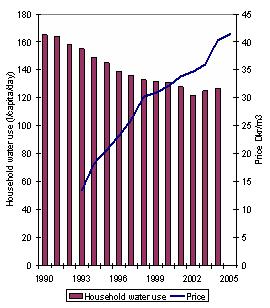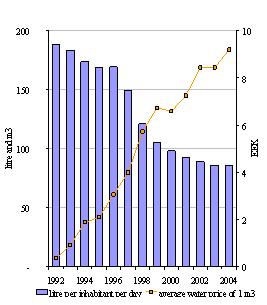Most countries have water resource management plans that address both supply and demand.
In EU, the Water Framework Directive (2000/60/EC) is based on the idea that modern water management needs to take account of ecological, economic (including pricing) and social functions throughout the entire river basin.
Water pricing is one of the measures used to reduce water demand. The Water Framework Directive requires EU Member States to ensure that by 2010 the proportion of the cost of water services – such as pumping, weirs, dams, channels, supply systems – with a negative impact on the environment – must be paid by the users (e.g. agriculture, hydropower, households, navigation). Member States are required to split the costs according to the ‘polluter-pays’ principle in order to reduce the impact on the environment and promote economic instruments to tackle the decline of natural resources. If Member States fail to include other infrastructures than drinking water supply and wastewater treatment in their economic analyses, there is a major risk that such infrastructures already identified as creating major environmental problems will be exempt. Consequently, the economic burden of water bodies reaching ‘good status’ by 2015 will remain with citizens, who already pay high prices for water services.
There has been a general trend towards higher water prices in real terms throughout Europe over the past 20 years, and wide variations in water charges exist both within individual countries and between different countries in Europe. This is due to the wide range of factors that determine local water prices and the level of recovery costs.
In several countries, increased water prices decreased household water use significantly (see figure below). In many eastern European countries, water prices were heavily subsidised until 1990. After 1990, there was a marked increase in prices in these countries during their transition to market-economies, resulting in lower water use. In Estonia, for example, water prices increased markedly after subsidies were removed, which in conjunction with water measuring and application of more advanced sanitation devices, led to a more than 50 % reduction in water use in the last 15 years (Figure WAT_PRICE_b).
WAT_PRICE: Effect of water price on household use in A) Denmark 1985-2004 and B) Estonia 1990-2004


Source: A) DEPA 2004 updated by EEA and B) Estonian Environment Information Centre, 2006
Measuring water use is a prerequisite for water prices reducing consumption. Households with water meters installed generally use less water than households without meters. In Europe, household and industrial water metering continues to increase. Many of the NWE countries already meter the majority of water uses. However, in many countries and in relation to agriculture water use metering is still limited.
When addressing water charges, focus should also be placed on households and agriculture that have difficulties with paying for water for essential purposes (since it is generally recognised that no one should have to compromise personal hygiene and health). The Water Framework Directive requires an affordable price to guarantee a basic level of domestic water supply (Article 12a).
Over the past 10 years there has been a marked increase in the amount of information provided to consumers (e.g. water-efficiency labels for households’ appliances, information on efficient lawn watering and gardening practices, etc.) and agriculture. Many countries, NGOs, large municipalities, water companies and international organisations have dedicated home pages to water conservation and water use behaviour.
Document Actions
Share with others